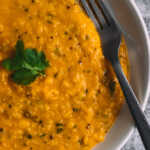This Bengali Masoor Dal Recipe is a staple in my home—comforting, aromatic, and always served with a steaming bowl of jeera rice. This simple yet flavorful lentil stew is packed with protein, essential nutrients, and warming spices that make it both nourishing and satisfying. Whether you’re a seasoned home cook or just starting your journey into Bengali cuisine, this recipe will guide you through the process of making a classic, homestyle masoor dal that’s as authentic as it is delicious.
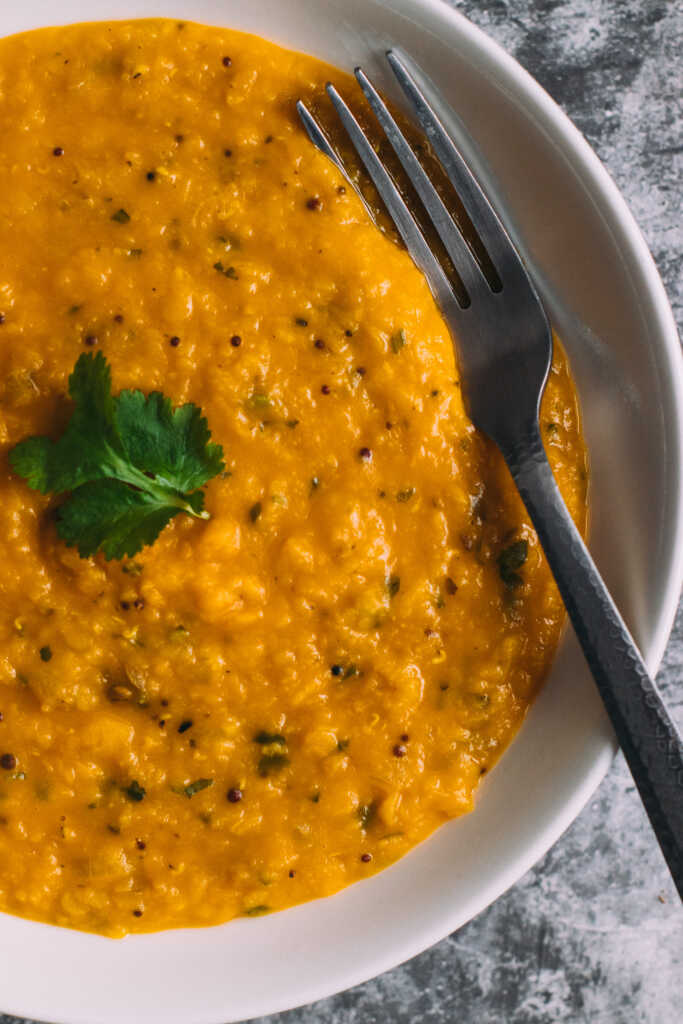
Quick Start: How to Make Bengali Masoor Dal in 5 Steps
1️⃣ Wash lentils and cook them with turmeric & bay leaf.
2️⃣ Prepare the tadka by frying onions, Panch Phoron, mustard seeds & dried chilies in oil.
3️⃣ Add garlic-ginger paste and sauté until aromatic.
4️⃣ Stir in tomato puree, cook for 1-2 minutes, then mix with the dal.
5️⃣ Season & finish with fresh coriander. Serve with basmati or jeera rice.
✨ For detailed measurements, troubleshooting tips, and pro secrets—keep reading!
Ingredients
- Masoor dal (red lentils)
- Panch Phoron (a spice mix of nigella seeds, cumin seeds, mustard seeds, fenugreek seeds and fennel seeds)
- Mustard seeds
- Sauteed Onion
- Garlic
- Ginger
- Green Chillies/red chillies (finger chillies)
- Turmeric powder
- Bay leaves
- Passata
- Fresh Coriander Leaves
Troubleshooting & Ingredient Substitutions
Troubleshooting Tips
- Dal too thick? Add more warm water and stir well until you get the desired consistency.
- Too bland? Adjust salt, add a little more tadka, or squeeze some fresh lemon juice for brightness.
- Overcooked lentils? No problem! A creamy texture is preferred, but if you like it chunkier, cook for less time or reduce stirring.
- Spice level too high? Remove the red chilies before serving or stir in a little coconut milk to mellow the heat.
Ingredient Substitutions
No tomato puree? Blend fresh tomatoes or use canned diced tomatoes.
No Panch Phoron? Try a mix of cumin seeds, mustard seeds, and fennel for a similar effect.
No fresh coriander? Use dried coriander leaves or chopped parsley as an alternative.
Health Benefits of This Bengali Masoor Dal Recipe
- High In Dietary Fiber
- Can Help with weight loss
- Good for digestion and the immune system
- Great source of carbohydrates for energy
- Rich source of protein
- Vegetarian and vegan-friendly
What Makes Panch Phoron Special?
Panch Phoron (meaning “five spices” in Bengali) is the signature spice blend of Bengali cuisine, adding layers of flavour to dal, curries, and vegetable dishes. Unlike other spice blends, Panch Phoron is always used whole, allowing the seeds to release their aromatic oils when tempered in hot oil.
The classic blend includes:
Fenugreek seeds – Slightly bitter, aids digestion
Nigella seeds (kalonji) – Nutty, earthy flavor
Cumin seeds – Warm, aromatic depth
Black mustard seeds – Adds mild heat
Fennel seeds – Slight sweetness, balances flavors
🌟 Pro Tip: If you don’t have Panch Phoron, mix cumin, mustard, and fennel for a similar effect!
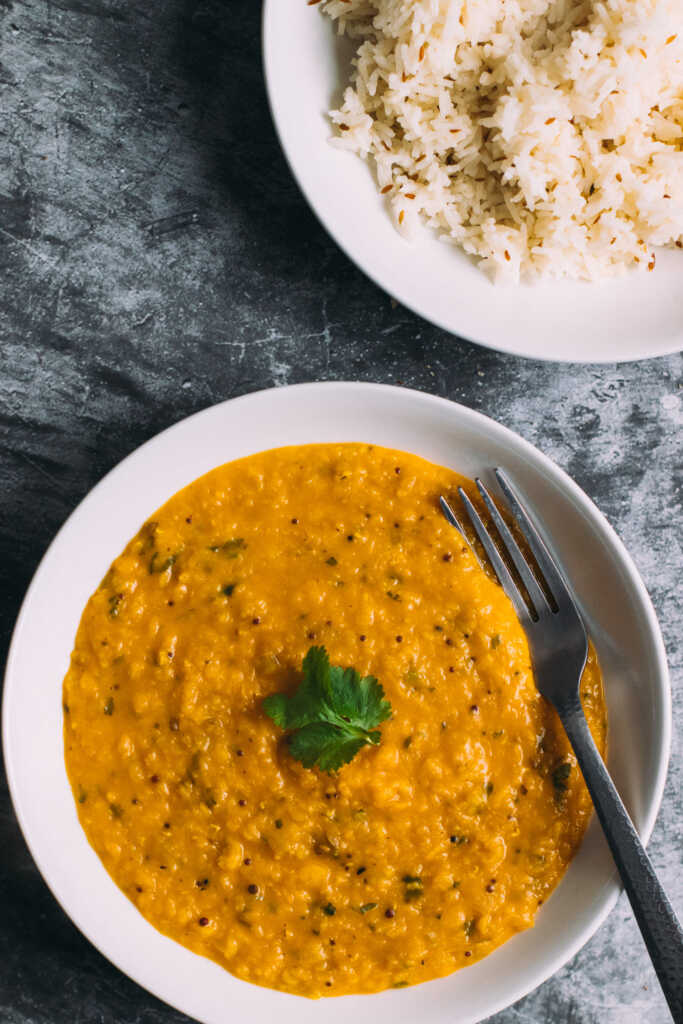
Why Tadka (Tempering) Is the Secret to Great Dal
Ever wondered why restaurant-style dals taste richer? The answer is Tadka—the simple yet powerful technique of frying whole spices in hot oil or ghee to unlock their full flavor potential.
Here’s how to perfect your tadka for Bengali Masoor Dal:
Heat vegetable oil or ghee in a small pan.
Saute chopped onions until they start to turn golden at the edges
Add mustard seeds, Panch Phoron, and dried red chilies. Wait until they start popping!
Stir in garlic-ginger paste—let it sizzle for a minute until fragrant.
Mix in passata (tomato puree) and cook for another minute.
Pour this fragrant tadka directly into the dal, mix well, and serve!
✨ Pro Tip: The key to an aromatic tadka is timing—don’t burn the spices, or they’ll turn bitter!
Making The Garlic Ginger Paste
The garlic ginger paste can be bought in jars in most supermarkets now but I find the taste quite dull when compared to making your own at home with fresh garlic and fresh ginger. It is so easy to make and so quick to make a small amount needed for a recipe like this. To make a small amount, around 1 tbsp, I use 2-3 garlic cloves with the same amount of ginger and grind it up in a pestle and mortar with a small amount of vegetable oil until a paste forms. Done!
How To Make This Bengali-Style Masoor Dal Recipe
- Step 1: Cook the Lentils
Wash 1 cup red lentils under cold water until the water runs clear.
In a saucepan, add 4 cups water, turmeric, and a bay leaf. Bring to a boil.
Simmer on medium heat for 20 minutes until soft and creamy. (For a quicker method, use a pressure cooker!)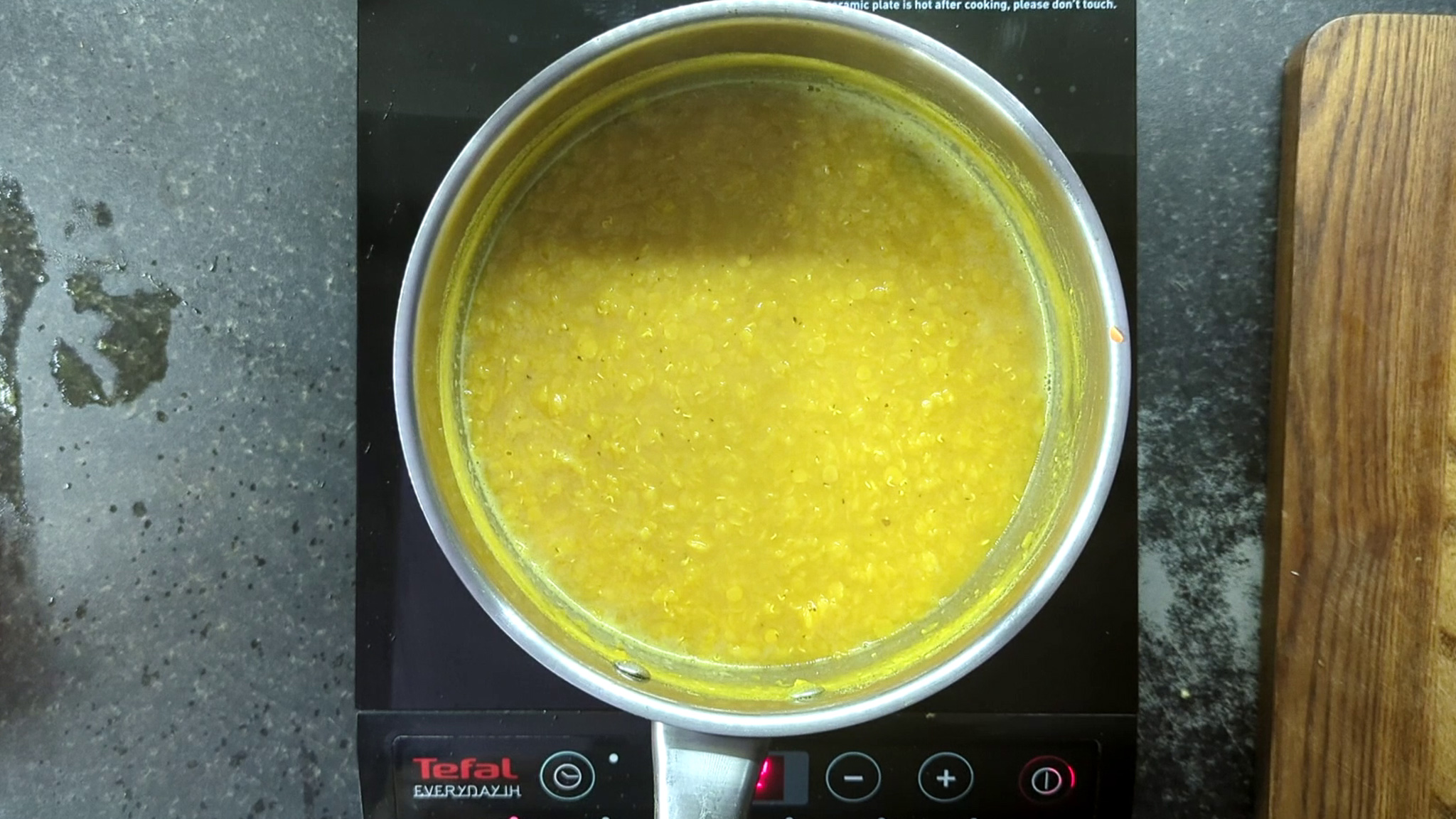
- Step 2: Prepare the Tadka (Flavor Boost!)
Heat 1 tbsp oil or ghee in a small pan.
Stir in 1 diced onion and cook until golden brown.
Add 1 tsp Panch Phoron, ½ tsp mustard seeds, and 2 dried red chilies. Sauté until they start popping.
Add 1 tbsp garlic-ginger paste and cook for 1 minute.
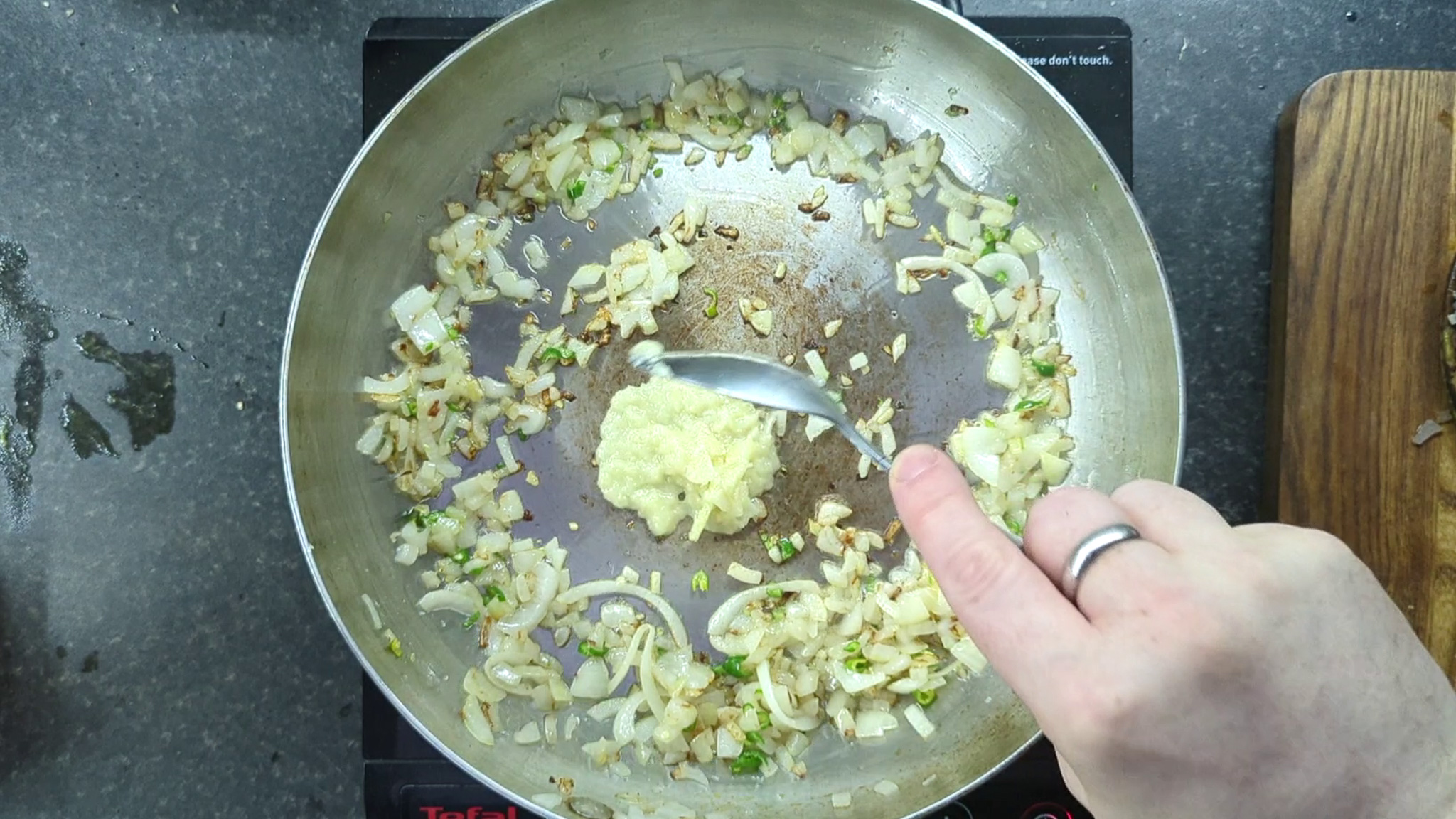
- Step 3: Combine & Finish
Mix in 1 tbsp tomato puree with a splash of water. Cook for another minute.
Pour the tadka into the cooked dal. Stir well.
Season with salt & pepper to taste, then add chopped coriander for freshness.
Serve with steamed basmati rice or jeera rice for a complete meal!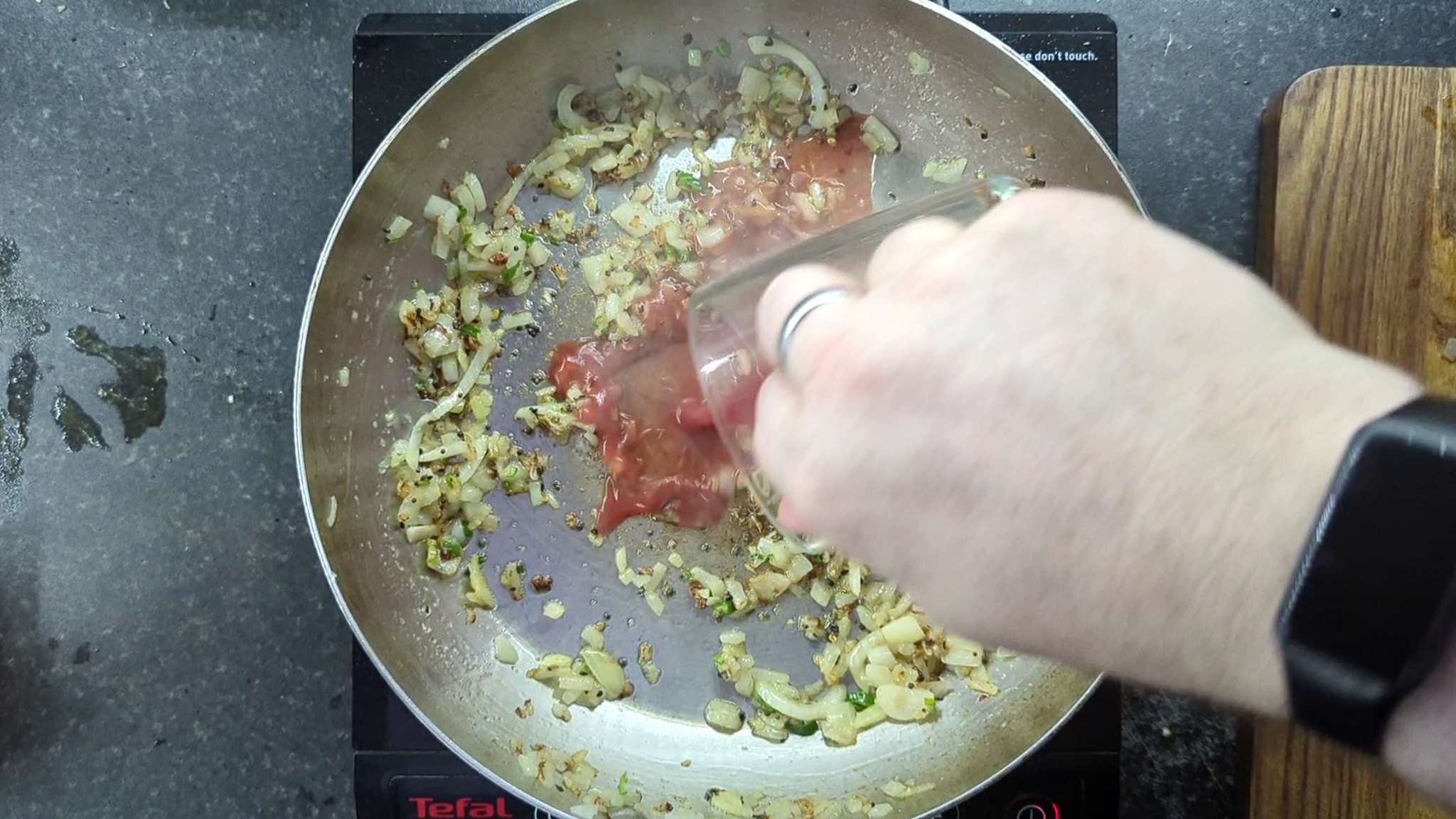
✅ Pro Tip: If the dal thickens too much as it cools, just add a splash of hot water before serving!
Why This Recipe Works
Congratulations! You’ve just mastered a classic Bengali Masoor Dal—a dish that’s simple to make but bursting with flavor. Whether you’re enjoying it on a cozy evening or sharing it with loved ones, this dal is pure comfort food. Try pairing it with jeera rice, naan, or a fresh salad for the perfect meal.
Have any questions? Comment below—I’d love to hear how your dal turned out! 😊
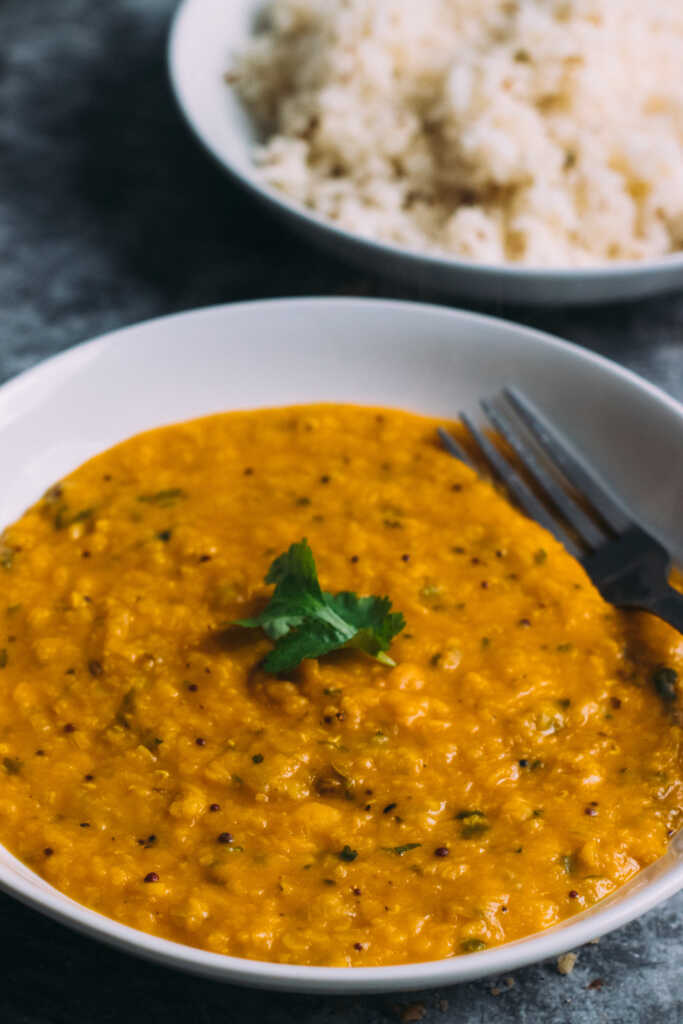
FAQ’s
Yes! Use the pressure cook function for 8 minutes and let the pressure release naturally for a creamy texture.
Masoor dal is red lentils, which cook quickly and have a mild, earthy flavor. Toor dal is yellow lentils, commonly used in South Indian sambar.
Can I use coconut milk in this recipe?
Yes! If you prefer a slightly creamy texture, add ¼ cup coconut milk at the end for a subtle sweetness.
What to Serve with Bengali Masoor Dal
Indian Breads – Enjoy with fresh naan, roti, or paratha for a complete meal.
Rice – Pair with steamed basmati rice or cumin-infused jeera rice.
Side Salad – A simple cucumber and tomato kachumber salad adds freshness!
Pickles & Chutneys – A side of mango pickle or mint chutney enhances flavors.
Pro Tip: For an authentic Bengali touch, serve with fried eggplant slices (Begun Bharta)!
Try Another Recipe
Quick Answer: How to Make Bengali Masoor Dal
To make Bengali Masoor Dal, cook red lentils with turmeric and bay leaf. Prepare a tadka with mustard seeds, Panch Phoron, onions, garlic-ginger paste, and tomatoes. Mix the tadka into the dal, season, and serve with rice!
Easy Bengali Masoor Dal Recipe
Equipment
- 1 saucepan
- 1 frying pan
- 1 set of measuring spoons
- 1 chefs knife
- 1 pestle and mortar
Ingredients
- 1 cup red lentils
- 4 cups water (more if needed)
- 1 tsp panch phoran
- ½ tsp black mustard seeds
- 1 medium diced onion
- 1 tbsp garlic ginger paste
- 2 chopped green finger chillies (use just 1 if you don't like it spicy)
- 1 tbsp tomato puree mixed with a little water
- ½ tsp turmeric
- chopped coriander
- 1 bay leaf
Instructions
- Begin by washing your lentils under cold water before adding them to the saucepan and adding the 4 cups of water.
- Add the turmeric and bay leaf and bring to a boil, then reduce to a gentle simmer.
- Whilst the lentils simmer, prepare the garlic ginger paste if you are making your own.
- Crush equal amounts of garlic and peeled ginger with a little vegetable oil in a pestle and mortar until a paste forms. Use around 2 large cloves and a piece of ginger around the size of your thumb to make the paste.
- Dice the onion and finely chop the green chillies.
- Add a little water to a tablespoon of tomato puree to make a quick passata
- Once the lentils are cooked down and getting creamy, its time to cook the tadka.
- Over medium high heat, fry the diced onions until turning golden at the edges
- Add the spices and chilli and cook for a minute or so, then add the garlic ginger paste. Cook until the spluttering stops, around a minute or so.
- Add the passata and cook out for a minute or two
- Remove from the heat and add the tadka to the dal
- Mix thoroughly then season the lentils to taste with salt and pepper, finishing off with some chopped coriander
Did you try this Bengali Masoor Dal? Let me know in the comments below! Tag me on Instagram [@scoffsandfeasts] so I can see your creations!

Hi, I’m Paul! I’m a passionate home chef, recipe developer, and food lover who believes that cooking should be fun, rewarding, and stress-free! Through Scoffs & Feasts, I share my favorite tried-and-tested recipes, cooking tips, and troubleshooting advice to help home cooks gain confidence in the kitchen. Whether you’re a beginner or an experienced foodie, I hope my recipes inspire you to try something new.

